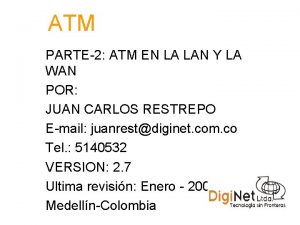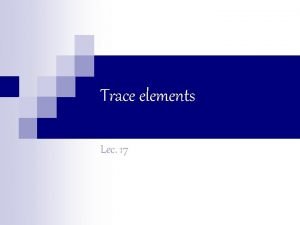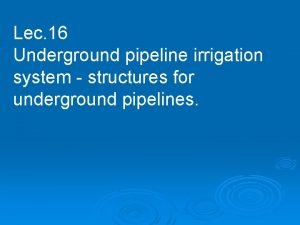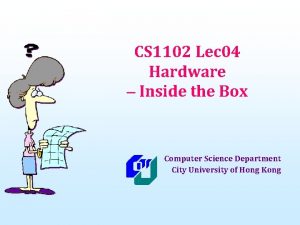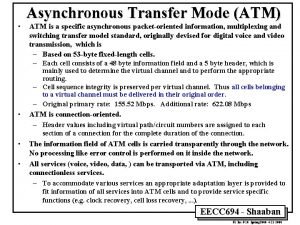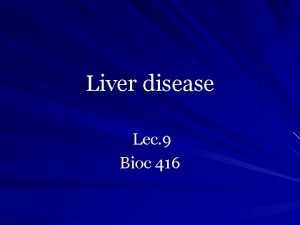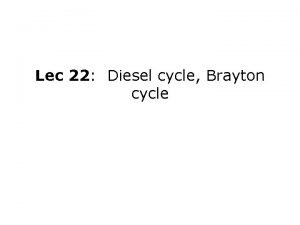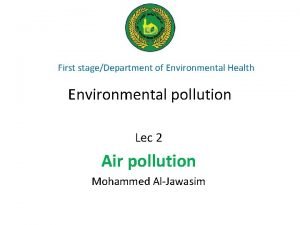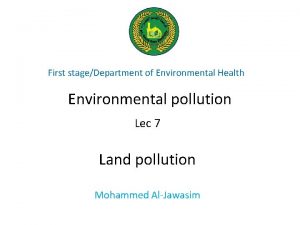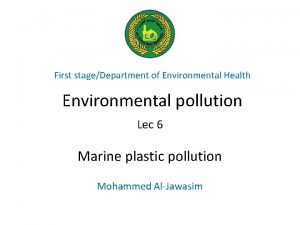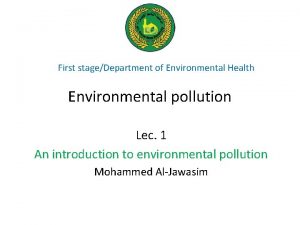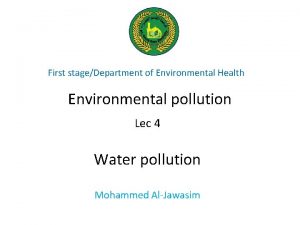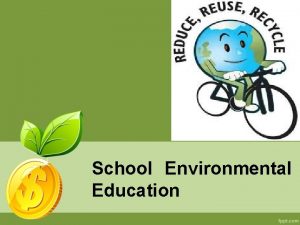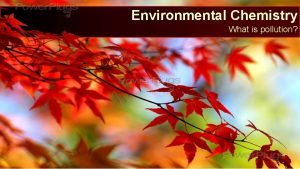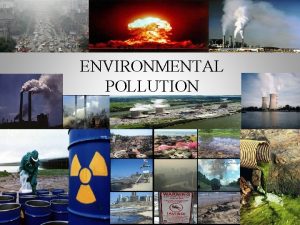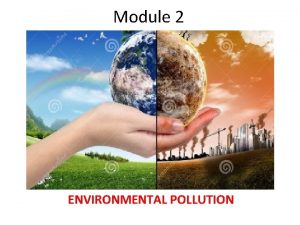First stageDepartment of Environmental Health Environmental pollution Lec



















- Slides: 19

First stage/Department of Environmental Health Environmental pollution Lec 5 Ground water pollution Mohammed Al-Jawasim

Groundwater • Groundwater: Water that comes from the ground— pumped out of wells or from springs • More than a quarter of the world’s population depends on groundwater for drinking water. • In U. S. , 50% of drinking water and 40% of irrigation water comes from groundwater

Groundwater source • 1 - Infiltration: Surface water soaking into ground —source of all ground water

Groundwater source • 2 -Water table: Uppermost surface of zone in Earth that is saturated with water • Surface to 10 -meters depth in Maine—Meets surface at base and the depth reaches to several hundred meters in deserts.

Groundwater source • 3 -Porosity: amount of open space in rocks and sediment that can hold water • Can be as high as 30% of rock volume

Groundwater source • 4 -Permeability: ability for fluids to flow in rock or sediment • Some rocks a very permeable, called aquifers • Others almost completely block ground water flow, called aquitards

Issues with groundwater • 1 -Cone of depression: Area around a well where water table is locally depressed due to withdraws • If cone of depression large enough, can lead neighboring wells to go dry

Issues with groundwater • 2 -Subsidence: ground surface-level drops due to groundwater withdraws

Issues with groundwater • 3 -Saltwater intrusion: in coastal areas large withdraws of fresh groundwater can allow saltwater to flow into aquifer


Groundwater pollution • Groundwater contamination is the result of human activity. • Chemicals or wastes that released to the environment has the potential to pollute ground water. • When ground water becomes contaminated, it is difficult and expensive to clean up.

How does groundwater become contaminated? • Depending on its physical, chemical, and biological properties, a contaminant move within an aquifer in the same direction that ground water moves other contaminants do not move. • Soils that are porous and permeable tend to transmit water and certain types of contaminants easily. • Ground water moves slowly, so do contaminants in ground water. Because of this slow movement, contaminants tend to remain concentrated in the form of a plume. • The size and speed of the plume depend on 1. the amount and type of contaminant, 2. its solubility and density, 3. and the velocity of the surrounding ground water.

Sources of groundwater pollution • Ground water can become contaminated from natural sources or human activities. • Residential, municipal, commercial, industrial, and agricultural activities can all affect ground water quality. • Contaminants reach ground water from activities on the land surface, such as releases or spills from stored industrial wastes; from sources below the land surface but above the water table, such as septic systems or leaking underground petroleum storage systems.

Natural Sources • Some substances found naturally in rocks or soils, such as iron, manganese, arsenic, chlorides, fluorides, sulfates, or radionuclides, can become dissolved in ground water. • Other naturally occurring substances, such as decaying organic matter, can move in ground water as particles.

Manmade sources • 1 -Septic systems: • Septic systems that are improperly sited, designed, constructed, or maintained can contaminate ground water with bacteria, viruses, nitrates, detergents, oils, and chemicals. • 2 -Improper Disposal of Hazardous Waste • Many chemicals should not be disposed of in household septic systems, including oils (e. g. , cooking, motor), lawn and garden chemicals, paints and paint thinners, disinfectants, medicines, photographic chemicals, and swimming pool chemicals.

Manmade sources • 3 -Releases and Spills from Stored Chemicals and Petroleum Products • Underground aboveground storage tanks are commonly used to store petroleum products and other chemical substances. • For example, • Many homes have underground heating oil tanks, businesses and municipal highway departments also store gasoline, diesel fuel, fuel oil, or chemicals in on-site tanks. • Approximately 4 million underground storage tanks exist in the United States and, over the years, the contents of many of these tanks have leaked and spilled into the environment.

Manmade sources • 4 -Landfills • the disposal of many household wastes, Solid waste and Chemicals are not regulated. • Once in the landfill, chemicals can leach into the ground water by means of precipitation and surface runoff. • 5 -Sewers and Other Pipelines • Sewer pipes carrying wastes sometimes leak fluids into the surrounding soil and ground water. • Sewage consists of organic matter, inorganic salts, heavy metals, bacteria, viruses, and nitrogen. • Other pipelines carrying industrial chemicals and oil brine have also been known to leak, especially when the materials transported through the pipes are corrosive.

Manmade sources • 6 -Improperly Constructed Wells • Problems associated with improperly constructed wells can result in ground water contamination when contaminated surface or ground water is introduced into the well. • 7 -Mining Activities • Active and abandoned mines can contribute to ground water contamination. • Precipitation can leach soluble minerals from the mine wastes (known as spoils or tailings) into the ground water below. These wastes often contain metals, acid, minerals, and sulfides.

Refereces • Hill, M. K. 2010. Understanding environmental pollution. 3 rd Edition. Cambridge University Press. • Radojevic, M. & Bashkin, V. 2007. Practical environmental analysis. 1 st edition. Royal Society of Chemistry. • Raven H. P. &Berg R. L. 2005. Environment. 5 th edition. United States of America: Wiley PLUS.




